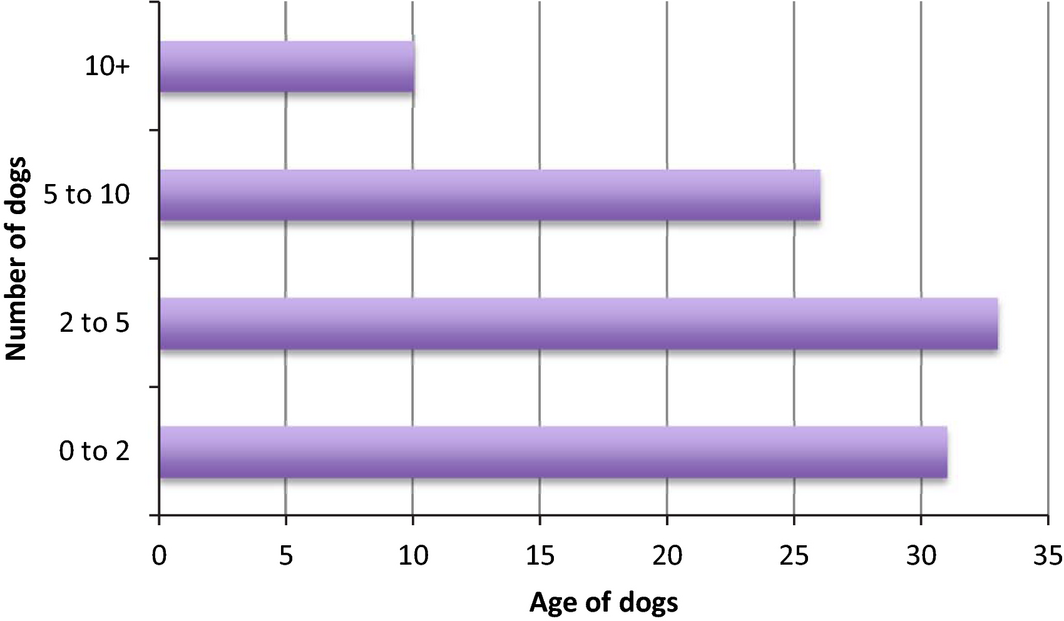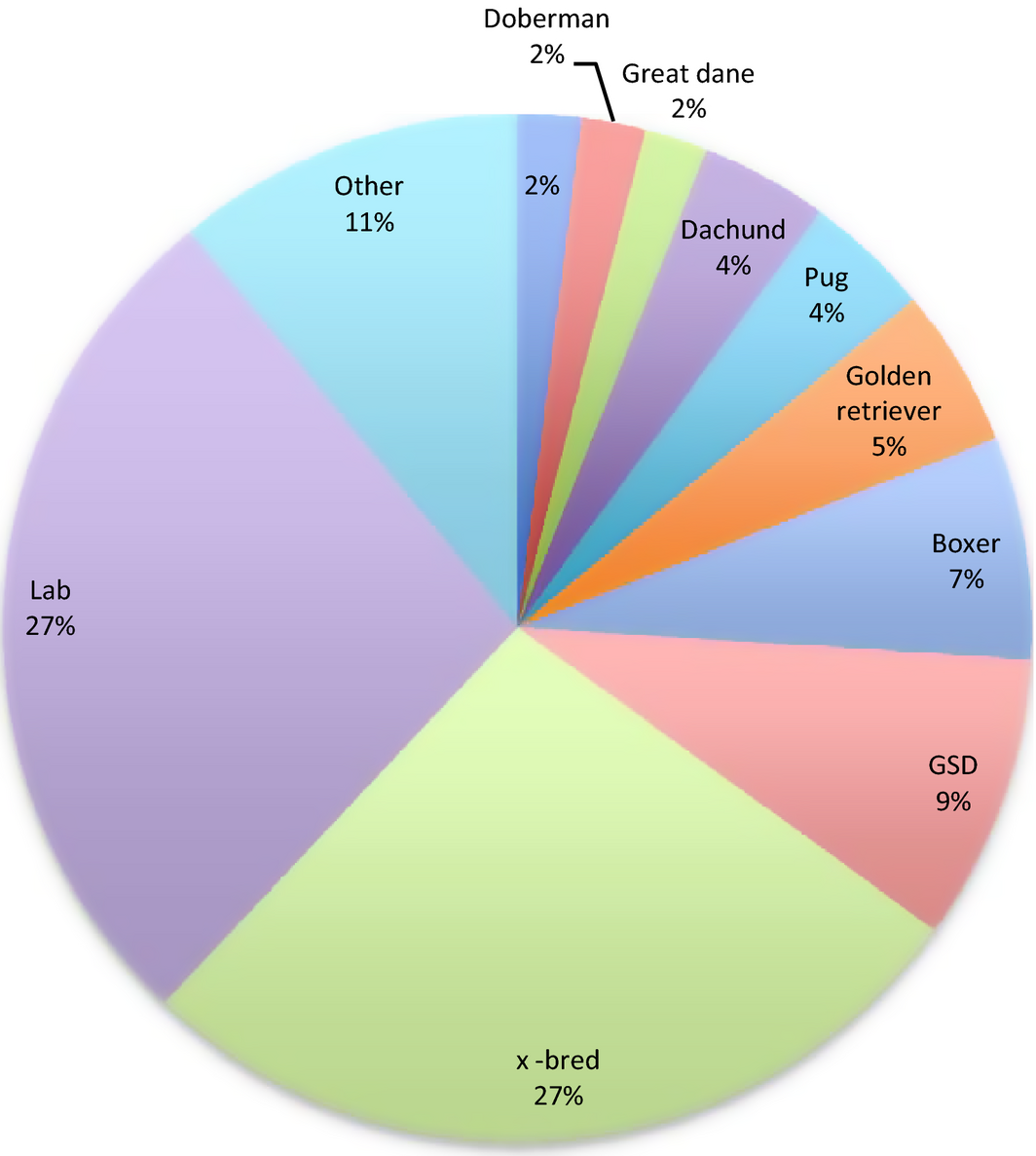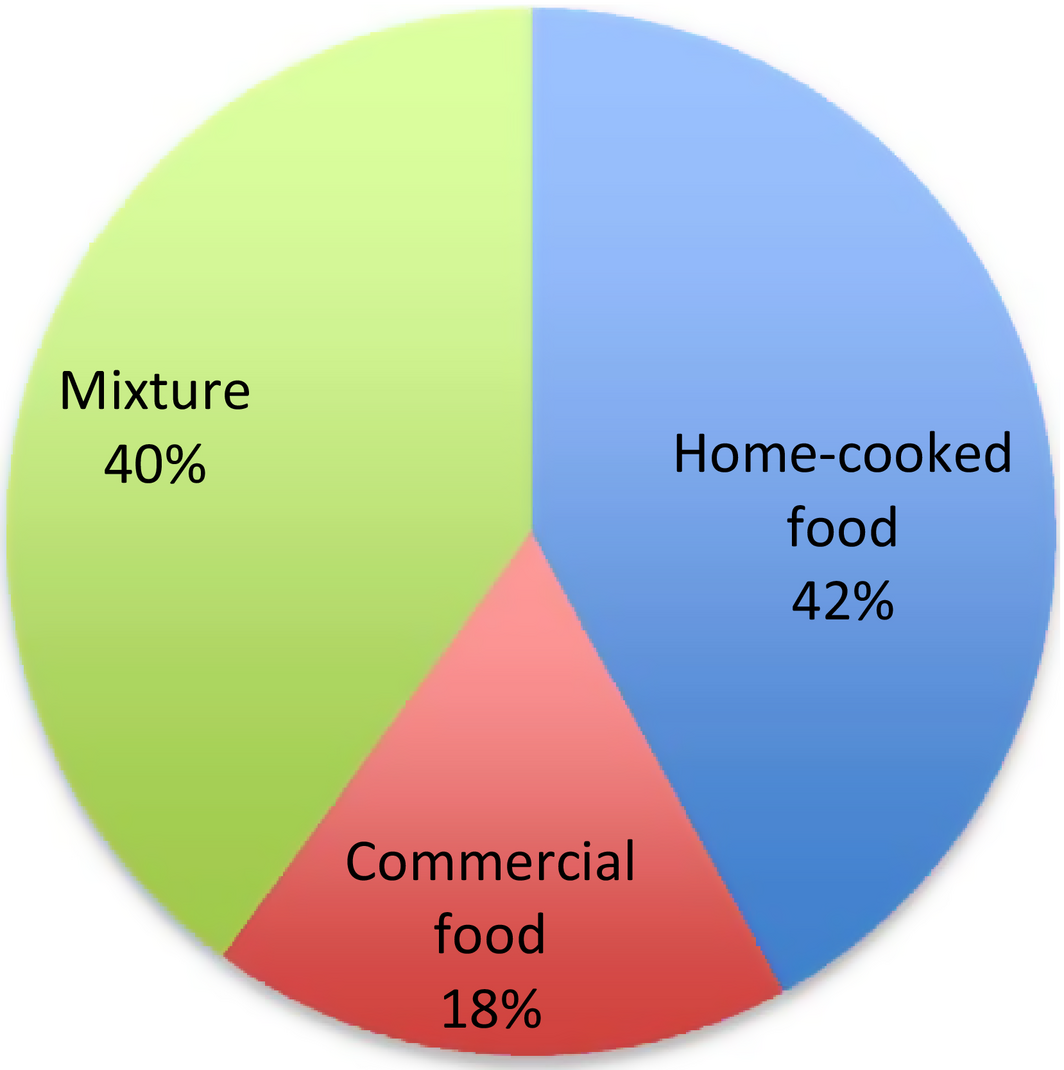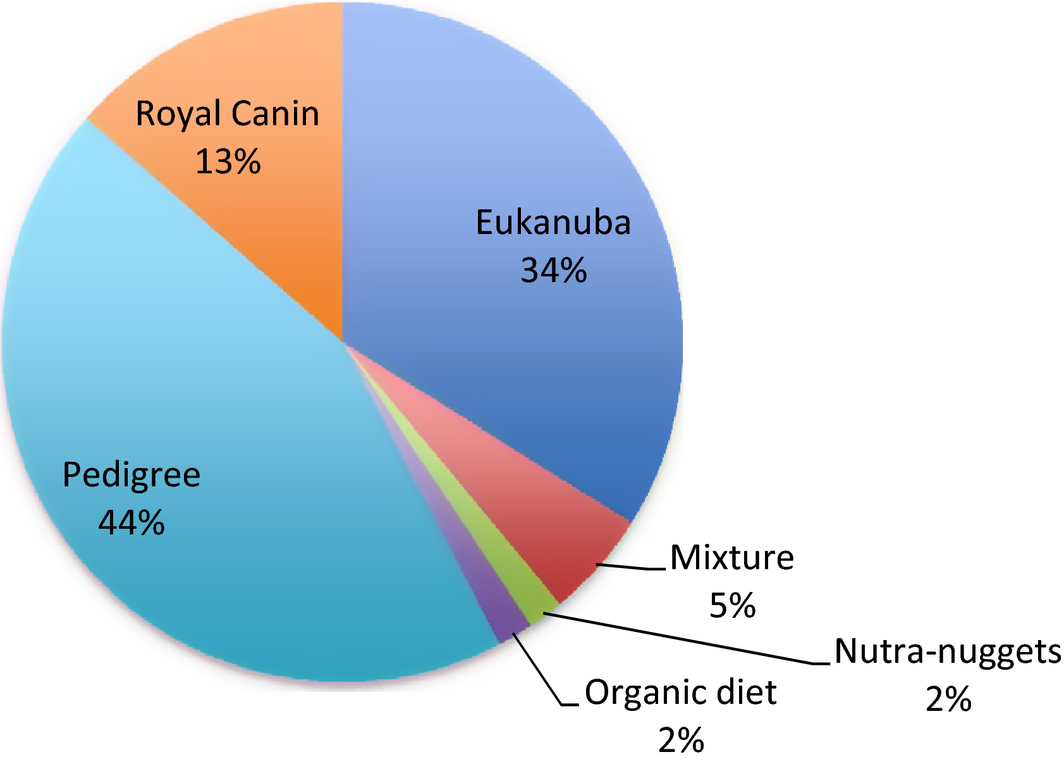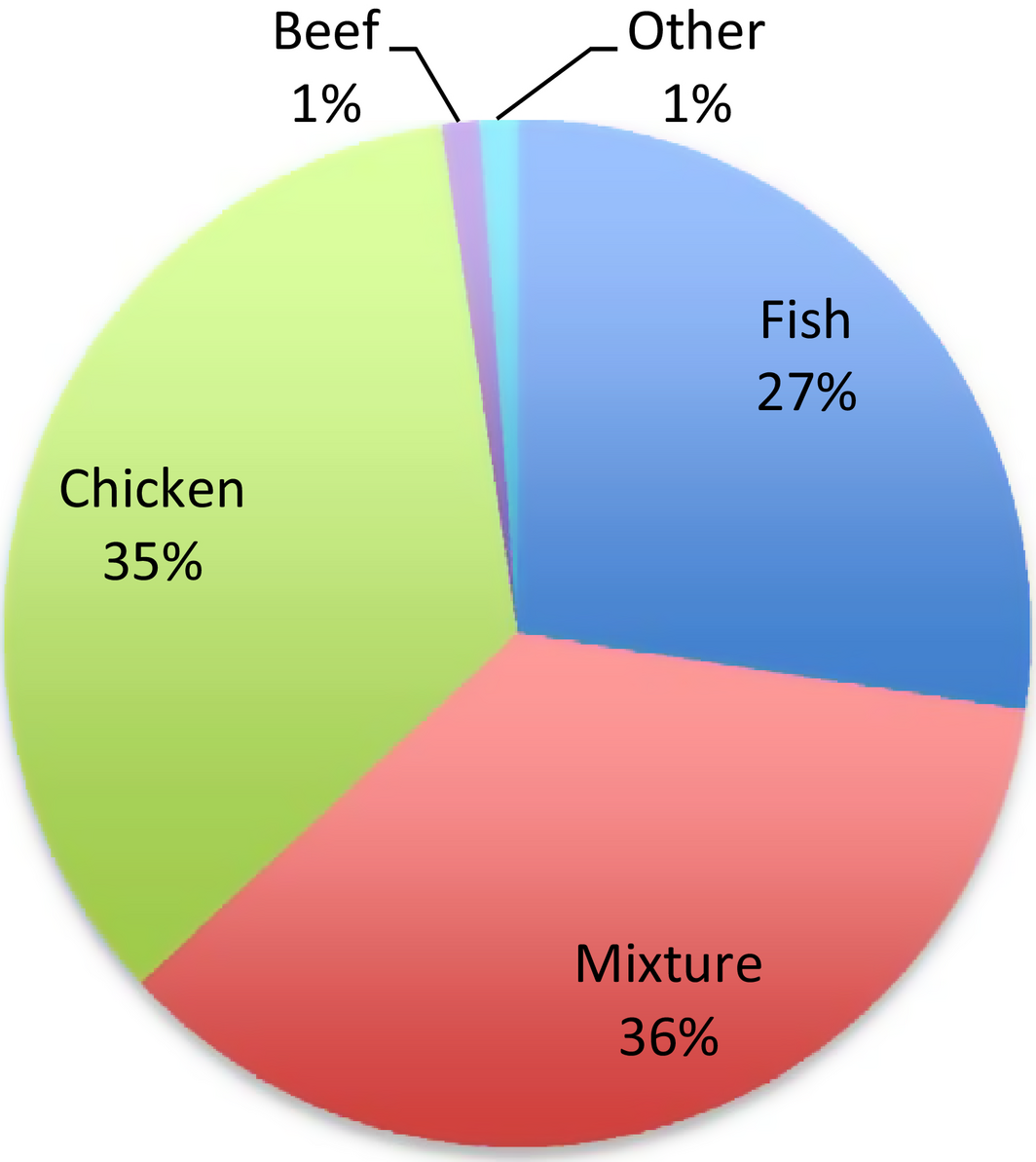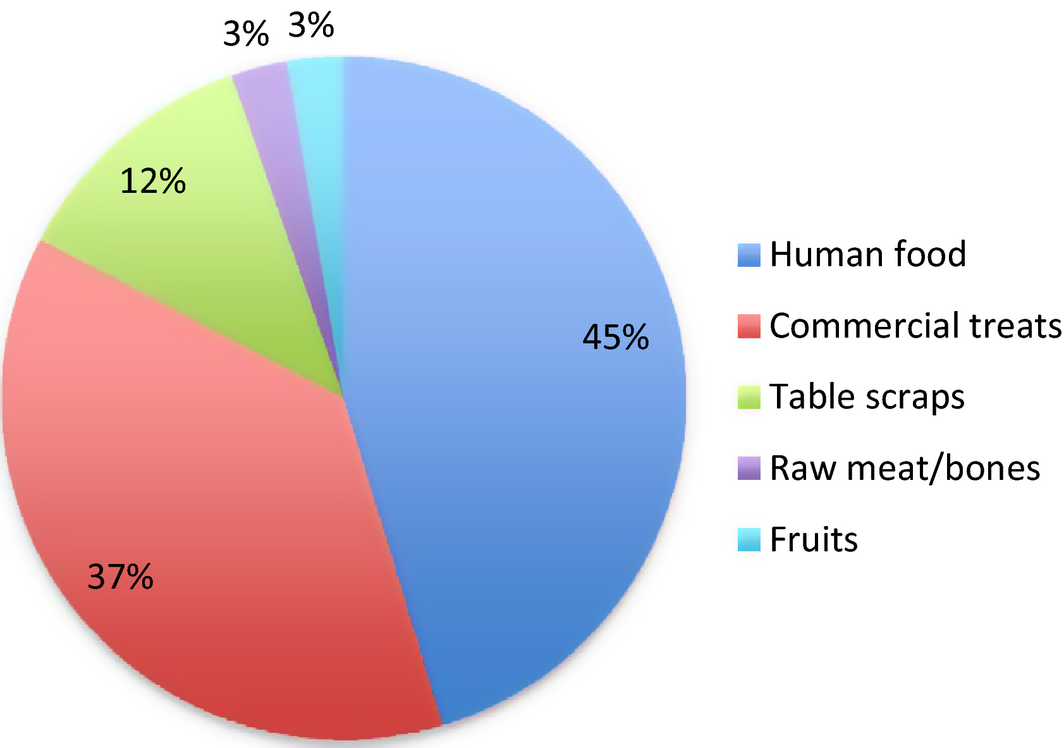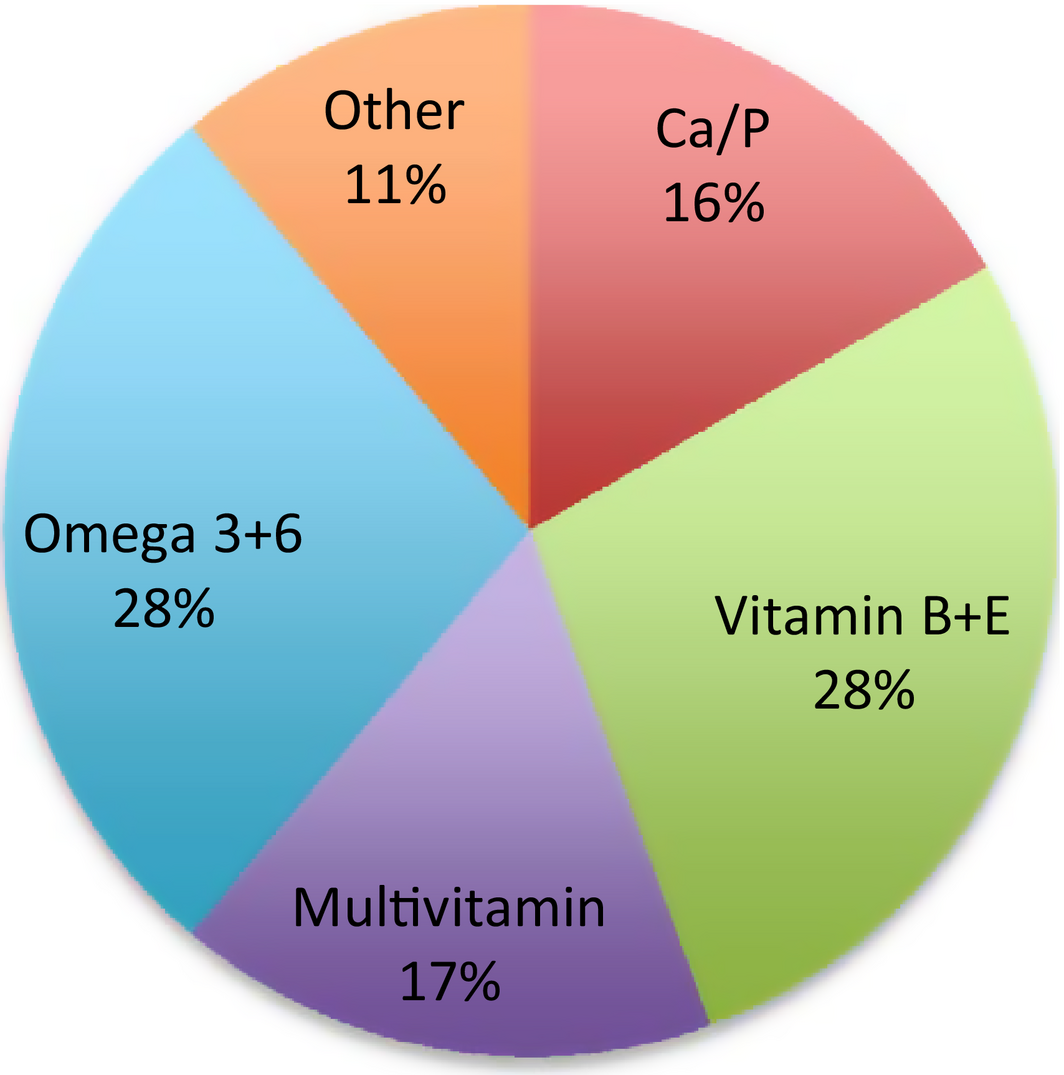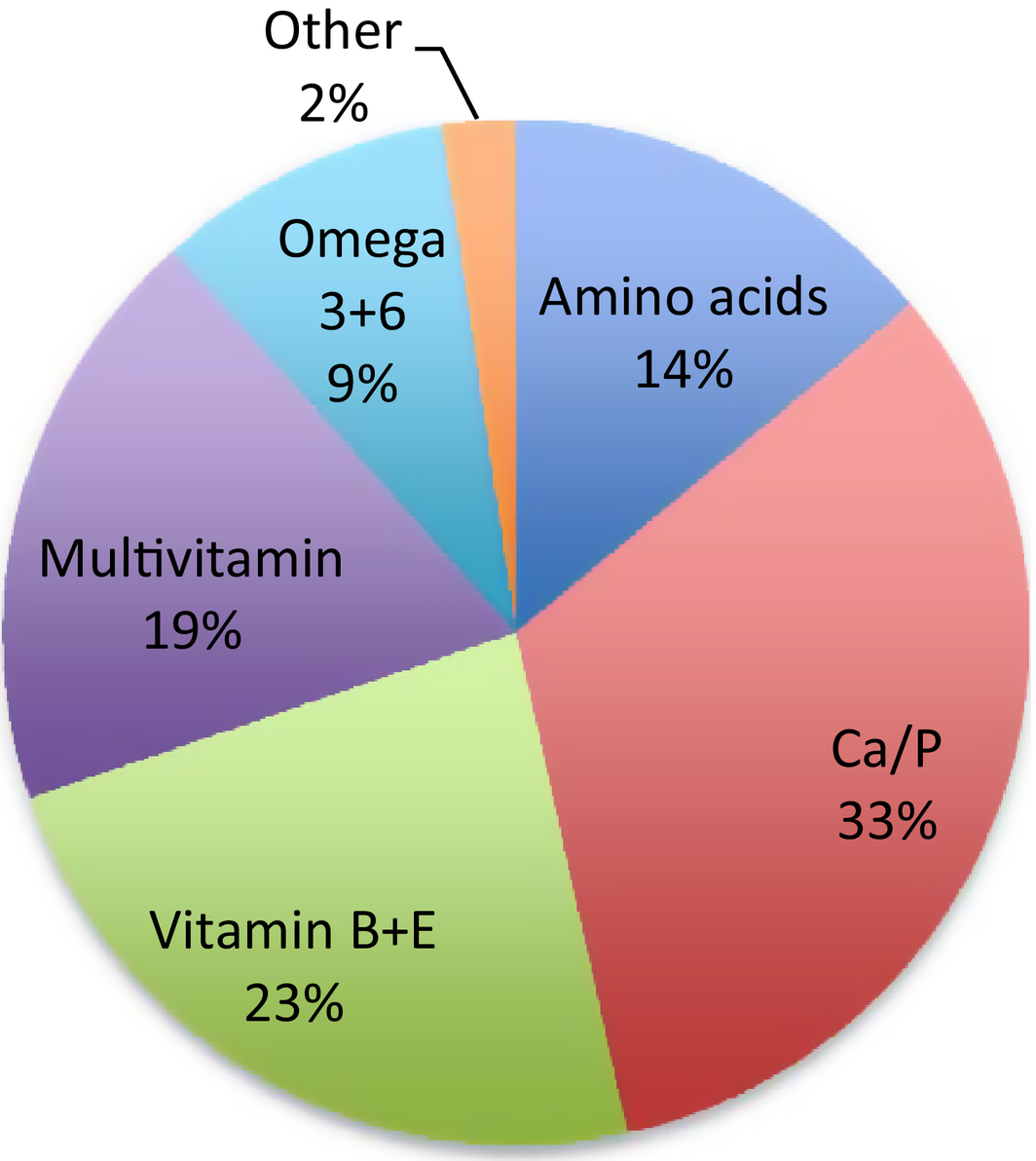Abstract
In Sri Lanka, home-cooked diets are often fed due to the cost and poor availability of commercial diets. Milk has traditionally been a popular food to give to dogs in this country. There is a recent perceived increase in the number of owners choosing commercial diets for their pets. This study aimed to determine how dog owners visiting a single veterinary practice in Colombo fed their pets. We hoped that this would help achieve a general understanding of pet feeding practices in Sri Lanka and gain some basic demographic information on the owned dog population. The study was conducted via questionnaires distributed to pet owners visiting a first opinion and referral practice in Colombo. Hundred questionnaires were collected and analysed, 69% of study dogs were neutered, 42% of dogs were fed only home-cooked food, while 18% were fed only commercial food. About 40% of dogs were fed a mixture of commercial and home-cooked food, 49% of dogs were fed milk as a separate meal in addition to their normal diet and 57% of dogs received dietary supplements. Dogs consuming commercial food for more than half their intake were no less likely (P = 0.75) to receive dietary supplements than dogs fed homemade food for more than half their diet. This study provides some basic information regarding the feeding practices and demographics of the owned dog population in one Sri Lankan city, Colombo, highlighting some areas of concern.
Introduction
Commercial diets for pets have only become available in Sri Lanka over the last 20–25 years. The first brand of commercial pet food to become available in the country was introduced in 1990 (M. Vigna, personal communication). They are still only available in major cities such as the financial capital Colombo. Historically, pets have been fed mostly leftovers of human food. However, with the introduction of commercial food brands in urban areas, there is a perceived increase in the number of owners opting for commercial diets for their pets.
In Sri Lanka, homemade diets are often fed due to the lack of availability of commercial diets and the increased cost as well as the precedent of feeding human leftovers to pets. In urban areas, increased veterinary attention and increased awareness regarding pet nutrition, means that homemade diets for pets are often specially prepared and supplemented with commercial mineral and vitamin supplements, sometimes but not always under veterinary guidance. The change in lifestyles in the cities and the increase in pedigree dog breeds as well as the increasing availability of commercial foods over the last 15 years means that owners are more likely to be interested in commercial pet foods. Data from the sales of one of the leading pet food brands in the country show that imports have increased from 2500 kg per month in 2000 to 60 000 kg per month in 2015 (M. Vigna, personal communication). Motivations to feed a commercial diet may include convenience and the advantage of a complete and nutritionally balanced diet without the need for supplements.
Conversely, most pets in developed countries are fed commercial food (Robertson 1999, 2003; Laflamme et al. 2008). The use of nutritionally complete and balanced commercial diets has been cited as a contributing factor for longer life spans in pets (Kraft 1998). A large study conducted over 1 year showed a decreased incidence of various health problems in pets fed a commercial diet compared to pets fed homemade vegetable or raw meat diets (Rahaman & Yathiraj 2000). However, there seems to be an increasing interest among pet owners in the developed world regarding the feeding of homemade diets or raw diets for their pets. Motivations for this increasing interest in alternative diets include increased control over their pets' diet, distrust in pet food companies, the desire to feed a more variable diet and the desire to feed a more natural diet (Remillard 2008; Weeth 2013).
Advocates of homemade diets cite various benefits such as increased control over ingredients used and their quality, avoidance of artificial preservatives, preservation of natural enzymes and phytonutrients, the ability to tailor the diet to meet specific needs of an individual pet and increased variation in diet (Berschneider 2002; Michel 2006). However, there is a lack of published data to support actual health benefits from such diets. A large study evaluating the nutritional adequacy of homemade diets showed that 95% of homemade diet recipes resulted in at least one essential nutrient at concentrations below guidelines set by the Association of American Feed Control Officials (AAFCO). The most common deficiencies were in calcium levels, micronutrients such as zinc, copper and choline and vitamins D and E (Dzanis 1993; Stockman et al. 2013). Another study showed that homemade diets are comparatively higher in dietary protein and significantly lower in calcium and calcium : phosphorus ratios when compared to commercial diets (Streiff et al. 2002). Several published case studies also report the development of clinical problems such as tetanic seizures, nutritional secondary hyperparathyroidism and osteopenia in growing puppies caused by a diet deficient in calcium and vitamin D or having an incorrect calcium : phosphorus ratio (Kawaguchi et al. 1993; De Fornel-Thibaud et al. 2007; Hutchinson et al. 2012). Studies analysing homemade diets designed for specific disease processes such as chronic kidney disease and cancer showed most diets to be nutritionally inadequate (Heinze et al. 2012; Larsen et al. 2012).
Currently, there is no data available on the feeding practices of pets in Sri Lanka or on the general demographics of the owned dog population in this country. A preliminary survey conducted in 2007 estimated the number of roaming dogs in the Colombo Municipal Council (CMC) area to be 3385 (95% confidence interval) and the number of owned dogs to be 15 640 (95% confidence interval) (Blue Paw Trust, Humane Dog Population and Rabies Control Project, unpublished observations).
The primary objective of this study was to determine how dog owners visiting a first opinion and referral centre in Colombo fed their pets. It was also aimed at testing the hypothesis that puppies in this population are more likely to be fed commercial food when compared to adult dogs.
Materials and methods
The study was conducted via questionnaires distributed to owners of pets visiting a first opinion and referral practice in Colombo, Sri Lanka. The practice was located in a relatively high-income area of the city. Clients in the waiting room were approached and informed of the study and those willing to participate were then handed a questionnaire. The first author was available for any questions, and to ensure that all the questionnaires were filled out completely. Clients were selected at random and the study was conducted over a period of 1 month.
The questionnaire was designed with the help of a local veterinarian and a university supervisor. The questions were aimed at finding out the proportion of dogs being fed commercial or homemade food, how much of the diet consisted of commercial or homemade food, the general components of a homemade diet, how many dogs were fed milk as a separate meal, the proportion of diets supplemented with mineral and vitamin supplements, the proportion of the dogs that were neutered and owner perception regarding their dogs' weight. Puppies were included in the survey with an aim to test the hypothesis that puppies are more likely to be fed commercial food when compared to adults. The questionnaire received ethical approval from the Ethics and Welfare Committee at the supervisors institution. A copy of the questionnaire is given in Appendix 1.
For the purpose of this study, puppies were defined as dogs below the age of 24 months. Commercial food was defined as any dry or moist manufactured diet. Homemade food was defined as food prepared at home.
Differences between responses were determined by the use of a z test for proportions and differences were considered significant at values of P < 0.05.
Results
This study received a 100% response rate. All the questionnaires collected were complete. Hundred completed questionnaires were collected in total giving rise to a study population of 100 dogs; 31 dogs were aged 0–2 years, 33 dogs were aged 2–5 years, 26 dogs were aged 5–10 years and 10 dogs were aged 10 and above (Fig. 1).
|
|
|
Figure 1. Age distribution of study population. |
Labrador retrievers and crossbreed dogs were the commonest breeds encountered in this study population (27% each) (Fig. 2).
|
|
|
Figure 2. Distribution of dog breeds represented in the study. |
The male : female ratio was 60:40. In total, 69% of dogs were neutered, of these 18% were male dogs and 50% female dogs (Table 1).
| Number | Percentage | |
|---|---|---|
| Female intact | 20 | 20 |
| Female neutered | 20 | 20 |
| Male intact | 49 | 49 |
| Male neutered | 11 | 11 |
Owner perception regarding weight of their dogs
Sixty-nine per cent of owners regarded their dogs' as being at an ideal weight, while 22% regarded their dogs as overweight.
Feeding practices
Most dogs (51%, n = 35) were fed two meals per day; 41% (n = 28) were fed three meals per day, 7% were fed one meal a day and 1% was fed four meals a day.
Forty-two per cent of dogs were fed homemade food only, while 18% were fed only commercial food; and 40% of dogs were fed a mixture of both commercial and homemade food (Fig. 3). Among those being fed a mixture, 47% of dogs (n = 19) were fed up to 25% of commercial food, 45% of dogs (n = 18) up to 50% of commercial food and 8% of dogs (n = 3) were fed up to 75% of commercial food. Thirty-nine per cent of dogs consumed commercial food for at least half their intake. There was no significant difference in the number of puppies and adult dogs fed commercial food for at least half their diet (Table 2).
|
|
|
Figure 3. Distribution of diet types fed to dogs in this study. |
|
|
|
Figure 4. Distribution of commercial food brands fed to dogs in this study. |
| Variable | Adults (n = 69) | Puppies (n = 31) | P-value |
|---|---|---|---|
| Commercial diet food for >50% of diet | 27 (39%) | 12 (39%) | 0.610 |
| Fed milk as a separate meal | 26 (38%) | 23 (74%) | <0.001 |
| Supplements included in diet | 32 (46%) | 25 (81%) | <0.001 |
One brand of commercial dog food accounted for 44% of the food fed. The second and third most popular brands were fed to 34% and 13% of dogs, respectively (Fig. 4).
In dogs fed homemade food, 35% (n = 29) were fed chicken as their main protein source and 27% (n = 23) were fed fish (Fig. 5). Eighty-three per cent of owners (n = 70) boiled the meat or fish prior to feeding and 17% of owners fed meat or fish in the form of a curry (n = 14). Two owners reporting to feeding only commercial food also reported to supplementing their dogs' diets with a homemade protein source. Two owners also reported feeding raw bones to their dogs.
|
|
|
Figure 5. Main protein source of homemade diets fed to dogs in this study. |
Most dogs fed homemade food were fed rice as the main carbohydrate source (95%, n = 75), while 5% of dogs (n = 4) were fed a mixture of rice and bread.
Forty-nine per cent of dogs were fed milk as a separate meal in addition to their normal diet. Puppies were significantly (P < 0.001) more likely to be fed milk than were adult dogs (Table 2).
Sixty-three per cent of owners report to feeding their dogs treats or snacks in addition to their main meals; 45% of owners (n = 34) fed types of food prepared for humans as treats, 37% (n = 28) fed commercial treats and 12% (n = 9) fed table scraps as treats (Fig. 6).
|
|
|
Figure 6. Types of treats or snacks provided to dogs in this study. |
Fifty-seven per cent of dogs received supplements in addition to their normal diet. Puppies were significantly (P < 0.001) more likely to receive supplements than were adult dogs (Table 2). The most commonly used supplement in adult dogs was vitamins B and E (Vetzyme®; seven seas pharmaceuticals) (28%, n = 15), whereas the most common supplement used in puppies was calcium and phosphorus (33%, n = 14) (Figs 7, 8).
|
|
|
Figure 7. Vitamin and mineral, and other supplements used in adult dogs in this study. |
|
|
|
Figure 8. Vitamin and mineral, and other supplements used in puppies in this study. |
Dogs consuming commercial food for more than half their intake were no less likely (P = 0.75) to receive dietary supplements compared to dogs fed homemade food for more than half their diet (Table 3).
| Variable | Dogs fed >50% commercial food | Dogs fed <50% commercial food | P-value | ||
|---|---|---|---|---|---|
| Number | Percentage | Number | Percentage | ||
| Supplements used in diet | 23 | 59 | 34 | 56 | 0.750 |
Discussion
The purpose of this study was to obtain information regarding the feeding practices of dogs visiting a first opinion and referral practice in Colombo, Sri Lanka. This study also provides some basic information regarding the demographics of the owned dog population in this region. The absence of other studies on the population of dogs in Sri Lanka means that it is not possible to determine the representativeness of the population included in this study. This study is biased in that it was conducted only at one private veterinary practice in Colombo in a high socioeconomic area and only looks at feeding practices of dogs receiving veterinary attention.
There are no previous studies of canine demographics and feeding practices in Sri Lanka. A survey conducted in 2007 gave an indication of the number of roaming dogs and owned dogs in the Colombo Municipal Council (CMC) area (Blue Paw Trust, Humane Dog Population and Rabies Control Project, unpublished observations). Comparison of this study population with data from studies conducted in the United Kingdom, United States and Australia may be useful in highlighting differences between dog populations in the developed world and the developing world.
In this study, 69% of dogs were neutered. A study conducted in the United States and Australia showed that 83.6% of the population was neutered (Laflamme et al. 2008). However, a larger study conducted in the United States with over 30 000 dogs, showed that only 61.5% of the population was neutered (Lund et al. 1999). These figures could indicate that the number of dogs being neutered in developing countries such as Sri Lanka is not too different from western populations. However, this study was conducted in an area of higher socioeconomic status so the proportion of dogs neutered may be greater than the proportion neutered in the general population. Interestingly, this study showed that 50% of female dogs were neutered, compared to only 18% of male dogs. Other studies in the United States showed that although more female dogs are neutered compared to male dogs, this difference was less marked with 87% of female dogs being neutered compared to 80% of male dogs (Lund et al. 1999; Laflamme et al. 2008). This difference may be explained by the fact that owned dogs in Sri Lanka do not commonly interact with other dogs and are exercised mainly on a lead. Therefore, sexual behaviours in male dogs are less likely to be a problem compared to western countries where dogs are more likely to interact with each other. The reason for more female dogs being neutered may also be due to the awareness programmes conducted for rabies and population control mainly in the Colombo municipal council area since 2007 (Blue Paw Trust, Humane Dog Population and Rabies Control Project, unpublished observations).
In this study, 27% of dogs were cross breeds and the most common pure breed was the Labrador retriever (27%). Results from a study conducted in the United States showed that similarly, 27% of dogs were cross breeds and the most common pure breed dog was the Labrador retriever (Lund et al. 1999). These figures indicate that this study population has a similar proportion of pure breed dogs when compared to a western population. This again could be due to the relatively high socioeconomic status of the region where this study was conducted.
Owners were questioned regarding the body condition of their pets; 22% regarded their pets as obese or overweight. Results from a study conducted in the United States revealed that 32.3% of owners regarded their dogs as overweight or obese, but less than 1% of these owners considered obesity to be a health problem (Freeman et al. 2006). It would be useful to compare the real body condition score to the owners perception of their dogs weight in a future study, but this was not part of the current study design.
In this study, most dogs were fed either two or three meals per day. Comparatively, the study conducted in Australia and the United States showed that most dogs were fed either once or twice a day (Laflamme et al. 2008). This may reflect the fact that most dogs are not left at home alone during the day in Sri Lanka and can therefore be fed up to three times although this hypothesis was not tested in the current study.
Only 39% of dog owners in this study fed their dogs commercial food for greater than 50% of the diet. Comparatively, greater than 90% of dogs in Australia and the United States were fed commercial food for more than 50% of their diet (Lund et al. 1999; Laflamme et al. 2008). Forty-two per cent of owners in this study fed their pets solely homemade diets. This figure was only 1.3% in a study conducted across the United States and 3% in a more recent study conducted in the United States and Australia (Lund et al. 1999; Laflamme et al. 2008). In this study, only 18% of owners fed solely commercial food. However, of the owners reporting to feed only commercial food, two owners reported to supplementing commercial food with a home-prepared protein source and seven owners reported to feeding milk as an additional meal. This indicates that the percentage of owners feeding solely commercial food in Sri Lanka is in fact less than reported previously in other countries.
While homemade diets can provide complete and balanced nutrition when properly formulated, a study conducted in India showed that dogs fed a homemade diet had a greater prevalence of health problems when compared to dogs fed commercial diets (Rahaman & Yathiraj 2000). Interestingly, a study comparing the nutritional adequacy of homemade and commercial diets for dogs showed that while home-prepared diets had several nutritional deficiencies when compared to AAFCO recommendations, serum biochemistry and complete blood counts for all dogs in the study were within normal limits. Serum parathyroid hormone levels were also within normal limits even though home-prepared diets had lower calcium : phosphorus ratios (Streiff et al. 2002). However, this study was conducted over only 30 days and signs of overt deficiency may take longer to develop. This study was also conducted in adult dogs that may be more capable of maintaining health with an unbalanced diet, when compared to puppies. It is thought that most dog owners in Sri Lanka do not feed homemade diets from recipes specifically formulated for dogs, although the current questionnaire did not investigate this. Therefore, there are significant nutritional concerns with these homemade diets. Complications arising from feeding nutritionally imbalanced diets include osteodystrophy, osteopenia and nutritional secondary hyperparathyroidism (Kawaguchi et al. 1993; De Fornel-Thibaud et al. 2007; Hutchinson et al. 2012). These dietary imbalances are of most concern in growing puppies, especially those of large or giant breeds where dietary calcium : phosphorus ratios and energy levels during the growing period have greater implications on health status (Schoenmakers et al. 2000; Lauten 2006). Labrador retrievers, the most popular breed in this study, are large breed dogs and would be at risk of diseases caused by nutritional imbalance during growth. Considering the health implications of a nutritionally balanced diet during the growing period, it was hypothesised that more owners might be feeding commercial food to puppies compared to those feeding commercial food to adults. However, this study showed that there was no significant difference between the proportion of puppies and adult dogs being fed commercial food for more than half their diet. This study population could however be too small to highlight a difference if it was present.
Specific concerns regarding nutrition highlighted in this study include supplementation of nutritionally balanced and complete pet food with home-prepared protein sources and/or milk. Most meat sources are high in phosphorus levels and supplementation can cause imbalances in the calcium : phosphorus ratio. Feeding milk in addition to commercial food may cause increased levels of calcium in the diet. Increased dietary calcium levels in growing puppies above optimum have been identified as a risk for the development of hip dysplasia, osteochondritis dissecans and other developmental orthopaedic diseases (Richardson 1992 May 1; Schoenmakers et al. 2000). In Sri Lanka, the practice of feeding milk to dogs as a separate meal is thought to be quite common. In this study, 49% of dogs were fed milk as a separate meal. A significantly higher proportion of puppies were fed milk compared to adult dogs. Twenty-six adult dogs were still fed milk and interestingly, lactose intolerance does not appear to be a significant problem in these dogs even though studies have shown demonstrated that adult dogs have a reduction in lactase production with age (Zentek et al. 2002). In this study, 17% of owners feeding a home-prepared protein source prepared the meat or fish in the form of a curry. Such preparations are most likely to contain onion and garlic, both implicated in the development of haemolytic anaemia in dogs (Harvey & Rackear 1985; Yamato et al. 2005).
Fifty-seven per cent of dogs in this study received dietary supplements. Studies in the United States and Australia report significantly lower figures of less than 10% (Freeman et al. 2006; Laflamme et al. 2008), thought to be due to the increased feeding of nutritionally complete commercial foods. Interestingly this study showed that dogs consuming commercial food for greater than half their intake were no less likely (P = 0.75) to receive dietary supplements compared to dogs fed homemade food for more than half their diet. A significantly higher proportion of puppies received supplements when compared to adult dogs and calcium and phosphorus was the most commonly used form of supplement. This highlights that vets and owners recognise that homemade diets may not have adequate levels of calcium for growth. However, personal experience of the author suggests that most vets prescribe supplementation without prior assessment of the dogs diet and often without good understanding of the calcium: phosphorus ratios in the prescribed supplement. Supplements are also readily available over the counter and therefore can be obtained by owners without veterinary advice. No attempt was made in this study to assess the nutritional content and adequacy of the homemade diets fed because the authors did not obtain enough details about the exact proportions of ingredients. However, a follow-up study analysing the diets more thoroughly to assess nutritional adequacy would be indicated, particularly focussing on calcium and phosphate ratios.
With increasing interest in the use raw diets in western countries, it was interesting to note that only two owners in this study reported to feeding raw bones to their dogs. Contrastingly, Laflamme and others showed that approximately one in four dogs in the Unites States and Australia frequently consumed raw meat or bones (Laflamme et al. 2008).
Conclusion
This is the first study of dog feeding practices in Sri Lanka and it highlights some areas of concern. Nutritionally balanced and complete commercial food is still only available in the main cities and cost remains an important factor. The majority of manufactured diets fed in this study were limited to three different brands. This reflects the limited choice of manufactured diets available in Sri Lanka compared with the UK or USA. It is therefore vital that veterinarians are competent in providing nutritional advice given the limitations of this environment. Comprehensive evaluation of a specific diet along with better understanding of the components of commercially available supplements is essential when providing nutritional advice. This study did not assess owner perception with regards to pet nutrition and this would be an interesting topic for future studies. It will also be useful to broaden this study to include a wider population including rural areas. Assessing longevity and health in dog populations fed different diets will be useful in comparing the benefits of homemade of food vs. commercial food. Specific analysis of homemade diets will aid in highlighting any nutritional deficiencies.
Acknowledgement
The authors thank the staff members and clients of the veterinary clinic for their help during the study.
Source of funding
None.
Conflicts of interest
None.
Contributions
None.
Appendix 1
Questionnaire on the feeding practices of dogs in Sri Lanka
- Details regarding your dog
- Age
- Breed
- Sex
- Is your dog neutered?
- Weight
- Do you consider your dog to be: (please circle as appropriate)
- Underweight
- Overweight
- At his/her ideal weight
- Do you feed your dog: (please circle as appropriate)
- Home-cooked food only
- Commercial food only
- A mixture of both
- If a mixture of both, approximately what percentage of commercial food do you feed your dog? (please circle as appropriate)
- 25%
- 50%
- 75%
- How many meals per day does your dog receive?
- Do you feed the same food at each meal or do you feed different foods?
If you feed commercial food as all or part of your dogs diet please answer the following questions. If you do not feed any commercial food please move to the next section.
- What brand of commercial dog food do you feed your dog?
- What type of diet is it? (please circle as appropriate)
- Adult diet
- Puppy diet
- Weight loss diet
- Specific breed diet (please specify breed)
- Other (please specify)
- How many meals of dog food (on its own or with home-cooked food) does your dog receive per day?
- How much does he/she receive per meal (g/cups)
If you feed home-cooked food as all or part of your dogs diet, please answer the following questions.
- How many meals of home-cooked food per day (on its own or with commercial food) does your dog receive?
- What do you feed your dog in a typical day?
- i.Main protein source (please circle as appropriate)
- a.Fish
- –Type of fish:
- b.Chicken
- – Chicken legs/wings/thighs/breast/neck/other (please delete as appropriate)
- c.Beef
- d.Other (please specify)
- Quantity (number of pieces/grams/cups) per day
- How is it cooked? (please circle as appropriate)
- Boiled
- Fried
- Other (please specify)
- ii.Main carbohydrate source (please circle as appropriate)
- a.Rice
- – White
- – Brown
- b.Bread
- – White
- – Red
- Quantity (cups/grams/number of slices) per day
- iii.Any other additions
- Vegetables (please specify what vegetables)
- Other (please specify and give details)
Additional questions
- 1.Is your dog given milk as a separate meal?
- i.Yes/No
- ii.If Yes:
- How many cups?
- What brand of milk do you use?
- Do you use full fat or non fat milk?
- If you use powdered milk, how many spoons of milk powder do you use?
- iii.Does he/she receive any additions along with milk?
- a.Bread
- Number of slices
- b.Biscuits (please specify type)
- Number of biscuits
- 2.Does your dog receive any additional treats during the day?
- Yes/No
- If Yes:
- What sort of treats (brand)
- Approximately how many per day
- 3.Does your dog receive any vitamin, mineral or other supplements?
- Yes/No
- If Yes:
- What type and brand of supplement?
- How many tablets/spoons/etc. per day?
References
- Berschneider H.M. (2002) Alternative diets. Clinical Techniques in Small Animal Practice17, 1–5.
- De Fornel-Thibaud P., Blanchard G., Escoffier-Chateau L., Segond S., Guetta F., Begon D.et al. (2007) Unusual case of osteopenia associated with nutritional calcium and vitamin D deficiency in an adult dog. Journal of the American Animal Hospital Association43, 52–60.
- Dzanis DA. (1993) The association of american feed control officials dog and cat food nutrient profiles: substantiation of nutritional adequacy of complete and balanced pet foods in the united states. Journal of nutrition124, 2535–2539.
- Freeman L.M., Abood S.K., Fascetti A.J., Fleeman L.M., Michel K.E., Laflamme D.P.et al. (2006) Disease prevalence among dogs and cats in the United States and Australia and proportions of dogs and cats that receive therapeutic diets or dietary supplements. Journal of the American Veterinary Medical Association229, 531–534.
- Harvey J.W. & Rackear D. (1985) Experimental onion-induced hemolytic anemia in dogs. Veterinary Pathology22, 387–392.
- Heinze C.R., Gomez F.C. & Freeman L.M. (2012) Assessment of commercial diets and recipes for home-prepared diets recommended for dogs with cancer. Journal of the American Veterinary Medical Association241, 1453–1460.
- Hutchinson D., Freeman L.M., McCarthy R., Anastasio J., Shaw S.P., Sutherland-Smith J. (2012) Seizures and severe nutrient deficiencies in a puppy fed a homemade diet. Journal of the American Veterinary Medical Association.241, 477–483.
- Kawaguchi K., Braga I.S., Takahashi A., Ochiai K. & Itakura C. (1993) Nutritional secondary hyperparathyroidism occurring in a strain of German shepherd puppies. Japanese Journal of Veterinary Research41, 89–96.
- Kraft W. (1998) Geriatrics in canine and feline internal medicine. European Journal of Medical Research3, 31–41.
- Laflamme D.P., Abood S.K., Fascetti A.J., Fleeman L.M., Freeman L.M., Michel K.E.et al. (2008) Pet feeding practices of dog and cat owners in the United States and Australia. Journal of the American Veterinary Medical Association232, 687–694.
- Larsen J.A., Parks E.M., Heinze C.R. & Fascetti A.J. (2012) Evaluation of recipes for home-prepared diets for dogs and cats with chronic kidney disease. Journal of the American Veterinary Medical Association240, 532–538.
- Lauten S. (2006) Nutritional risks to large-breed dogs: from weaning to the geriatric years. The Veterinary Clinics of North America. Small Animal Practice.36, 1345–1359, viii.
- Lund E., Armstrong P. & Kirk C. (1999) Health status and population characteristics of dogs and cats examined at private veterinary practices in the United States. Journal of the American Veterinary Medical Association214, 1336–1341.
- Michel K.E. (2006) Unconventional diets for dogs and cats. The Veterinary Clinics of North America. Small Animal Practice.36, 1269–1281, vi–vii.
- Rahaman S.A.& Yathiraj S. (2000) Commercial versus traditional food in canine health. Compendium on Continuing Education for the Practicing Veterinarian22, S97.
- Remillard R.L. (2008) Homemade diets: attributes, pitfalls, and a call for action. Topics in Companion Animal Medicine23, 137–142.
- Richardson D.C. (1992) The role of nutrition in canine hip dysplasia. The Veterinary Clinics of North America. Small Animal Practice.22, 529–540.
- Robertson I. (1999) The influence of diet and other factors on owner-perceived obesity in privately owned cats from metropolitan Perth, Western Australia. Preventive Veterinary Medicine40, 75–85.
- Robertson I.D. (2003) The association of exercise, diet and other factors with owner-perceived obesity in privately owned dogs from metropolitan Perth, WA. Preventive Veterinary Medicine58, 75–83.
- Schoenmakers I., Hazewinkel H.A., Voorhout G., Carlson C.S., Richardson D. (2000) Effects of diets with different calcium and phosphorus contents on the skeletal development and blood chemistry of growing great danes. The Veterinary Record. BMJ Publishing Group Limited147, 652–660.
- Stockman J., Fascetti A.J., Kass P.H. & Larsen J.A. (2013) Evaluation of recipes of home-prepared maintenance diets for dogs. Journal of the American Veterinary Medical Association242, 1500–1505.
- Streiff E.L., Zwischenberger B., Butterwick R.F., Wagner E., Iben C., Bauer J.E. (2002) A comparison of the nutritional adequacy of home-prepared and commercial diets for dogs. Journal of NutritionAmerican Society for Nutrition132 (6 Suppl 2), 1698S–1700S.
- Weeth L.P. (2013) Focus on nutrition: home-prepared diets for dogs and cats. Compendium on Continuing Education for the Practicing Veterinarian35, E3.
- Yamato O., Kasai E., Katsura T., Takahashi S., Shiota T., Tajima M.et al. (2005) Heinz body hemolytic anemia with eccentrocytosis from ingestion of Chinese chive (Allium tuberosum) and garlic (Allium sativum) in a dog. Journal of the American Animal Hospital Association41, 68–73.
- Zentek J., Marquart B., Pietrzak T. (2002) Intestinal effects of mannanoligosaccharides, transgalactooligosaccharides, lactose and lactulose in dogs. Journal of Nutrition. American Society for Nutrition132 (6 Suppl 2), 1682S–1684S.
Document information
Published on 09/06/17
Submitted on 09/06/17
Licence: Other
Share this document
Keywords
claim authorship
Are you one of the authors of this document?
